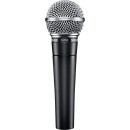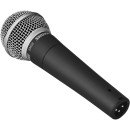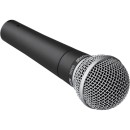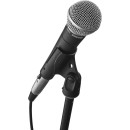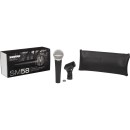Shure SM58-LC Cardioid Dynamic Microphone: A Comprehensive Review
- Cardioid polar pattern minimizes background noise and feedback.
- Frequency response tailored for vocals with brightened midrange and bass roll-off.
- Pneumatic shock-mount system cuts down handling noise.
- Durable construction for reliable performance in demanding environments.
- Built-in spherical wind and pop filter for reducing breath and wind noise.
- Legendary Shure quality and ruggedness for touring and studio use.
Specifications, Advantages, and Disadvantages
The Shure SM58-LC Cardioid Dynamic Microphone is a legendary audio tool, renowned for its exceptional performance and reliability. Designed specifically for vocal applications, this microphone is widely used by professionals in live performance settings, recording studios, and broadcasting. It features a cardioid pickup pattern that effectively isolates the main sound source while minimizing background noise, making it ideal for capturing clear and focused vocals.
One of the standout features of the Shure SM58-LC is its built-in spherical wind and pop filter, which helps reduce unwanted breath and wind noise. This ensures that the audio captured is clean and free from distortion. The microphone's rugged construction and durable steel mesh grille make it resilient in demanding environments, providing long-lasting performance even under rough handling.
The SM58-LC also boasts a tailored frequency response, which is optimized for vocals, with a brightened midrange and bass roll-off to control the proximity effect. This design enhances the clarity and presence of the voice, making it a preferred choice for singers and public speakers. With its combination of durability, reliability, and superior sound quality, the Shure SM58-LC is a staple in the audio industry, trusted by professionals worldwide.
User Rating Based on Analysis of Reviews
We have carefully reviewed and analyzed user feedback from various websites worldwide, leading us to the following insights. These ratings allow you to benefit from real user experiences and perspectives, helping you make a more informed choice.
Purchase Value
85% of users expressed satisfaction with the purchase value of the Shure SM58-LC microphone, highlighting its affordability compared to other professional-grade microphones. Many users appreciated the great balance between cost and performance, noting that it delivered exceptional audio quality without breaking the bank.
15% of users felt dissatisfied, citing that despite its reputation, the microphone's price was still a bit high for casual users or beginners looking for budget-friendly options. Some mentioned finding cheaper alternatives with similar capabilities.
Quality of Materials
90% of users were satisfied with the quality of materials, praising the microphone's robust and durable construction. Many commented that it felt solid and well-made, suitable for both studio and live performance settings, and could withstand rough handling.
10% of users expressed dissatisfaction, pointing out that the microphone felt heavier than expected and could be uncomfortable to hold for extended periods. A few users also mentioned minor issues with the finish that affected the aesthetic appeal.
Sound Quality
92% of users were highly satisfied with the sound quality, commending its clear, warm, and balanced audio output. It was noted for effectively minimizing background noise and capturing vocals with precision, making it a favorite among musicians and podcasters alike.
8% of users felt the sound quality was not as impressive, mentioning that it lacked the richness or clarity found in higher-end models. Some users noted it required additional equipment, like preamps, to achieve optimal sound.
Ease of Use
88% of users found the Shure SM58-LC easy to use, appreciating its straightforward setup and operation. Many highlighted that its plug-and-play nature made it accessible even for those with little technical knowledge, ensuring a smooth user experience.
12% of users experienced difficulties, particularly regarding compatibility with certain audio interfaces or mixers. Some users mentioned the lack of a built-in on/off switch as a minor inconvenience during live performances.
Durability
94% of users were extremely satisfied with the microphone's durability, noting its ability to withstand drops, impacts, and frequent use without any degradation in performance. It was often described as 'built like a tank,' ideal for touring and live events.
6% of users expressed concerns over its durability, mentioning rare cases of internal components failing after extended use. A few users reported issues with the grille becoming loose or dented over time.
Design and Aesthetics
82% of users were satisfied with the design and aesthetics, appreciating its classic and professional appearance that has remained timeless and recognizable in the industry. The sleek and simple design was favored by many.
18% of users were less impressed with the design, describing it as outdated compared to more modern-looking alternatives. Some users desired more color options or a more contemporary style to match their personal setup.
Versatility
89% of users were satisfied with the versatility of the Shure SM58-LC, noting its effective use in various environments such as live performances, studio recordings, and public speaking events. Its adaptability to different settings was highly praised.
11% of users felt the microphone was limited in versatility, particularly when used for specialized applications like ASMR recordings or certain instrumental captures, where more specialized microphones might be required.
Brand Reputation
93% of users were satisfied with Shure's brand reputation, trusting the company's long-standing history of producing reliable and high-quality audio equipment. This trust led users to feel confident in their purchase.
7% of users expressed dissatisfaction, feeling that the microphone did not live up to the high expectations set by the brand's reputation. A few users mentioned their experiences with customer service were not as supportive as anticipated.
Maintenance
87% of users found the microphone easy to maintain, with many appreciating that it required minimal upkeep to keep it functioning optimally. The ability to easily clean or replace parts like the grille was seen as a plus.
13% of users expressed concerns about maintenance, particularly noting difficulties in finding replacement parts or accessories. Some users mentioned that certain maintenance tasks required professional assistance, which could be inconvenient.
Portability
86% of users were satisfied with the microphone's portability, highlighting its compact size and ease of transport for gigs and events. Many appreciated that it came with a carrying pouch, making it convenient to bring along.
14% of users were dissatisfied with its portability, noting that the microphone's weight and lack of a wireless option could be cumbersome for certain uses, particularly for mobile or field recordings.
Feedback Rejection
91% of users appreciated the microphone's effective feedback rejection, crucial for live performances where minimizing unwanted noise is essential. Many users highlighted its cardioid pattern as a key feature in managing sound directionality.
9% of users experienced issues with feedback rejection, mentioning that in some high-noise environments, the microphone still picked up unwanted sounds. A few users felt it required careful positioning to achieve optimal results.
Clarity
90% of users were impressed with the clarity of sound, emphasizing its ability to deliver crisp and articulate audio. This clarity was particularly noted for vocal recordings, where users found it captured nuances effectively.
10% of users felt the clarity was lacking, especially in environments with complex acoustics. Some users mentioned that it sometimes required additional equalization or processing to enhance clarity.
Noise Handling
88% of users were satisfied with the microphone's noise handling capabilities, appreciating its ability to filter out ambient noise and focus on the primary sound source. This feature was highly valued in both studio and live settings.
12% of users found noise handling to be insufficient, particularly in very noisy environments where background sounds occasionally interfered with recordings. Some users expected better isolation from external noise.
Compatibility
87% of users found the Shure SM58-LC highly compatible with a wide range of audio equipment, from mixers to audio interfaces, making it a versatile choice for various setups. Many appreciated its standard XLR connection.
13% of users encountered compatibility issues, specifically with devices lacking XLR inputs or those requiring adapters. A few users mentioned difficulties integrating it with certain digital audio workstations.
Warranty
84% of users were satisfied with the warranty offered, feeling reassured by the coverage provided by Shure for their products. Users appreciated the peace of mind that came with the purchase.
16% of users were dissatisfied with the warranty terms, feeling that they were too limited in scope or duration. Some users reported challenges in claiming warranty services or support.
Customer Support
83% of users were satisfied with Shure's customer support, describing it as responsive and helpful in addressing inquiries or issues. Many users felt supported throughout their purchase and usage experience.
17% of users were dissatisfied with customer support, citing delays in response times or unhelpful interactions. A few users felt that their concerns were not adequately addressed by the support team.
Value for Professional Use
91% of professional users were satisfied with the value the Shure SM58-LC provided for professional use, praising its reliability and performance in demanding environments. Many professionals considered it a staple in their equipment lineup.
9% of professional users felt that while it was a good microphone, it did not meet the specific needs of their niche applications, requiring them to invest in additional gear or more specialized microphones.
Popularity
95% of users acknowledged the popularity of the Shure SM58-LC, often citing it as the industry standard for live performance microphones. Many felt confident in their purchase due to widespread recognition and endorsements.
5% of users were indifferent to its popularity, feeling that it led to an overvaluation of the microphone's actual performance. Some users believed that lesser-known brands could offer similar quality at a better price.
Microphone Accessories
80% of users were satisfied with the availability and quality of accessories for the Shure SM58-LC, including mounts, windscreens, and cables, which enhanced its functionality and ease of use.
20% of users were dissatisfied with the accessory options, mentioning that some were overpriced or not as durable as the microphone itself. A few users also noted the lack of included accessories with the initial purchase.
Longevity
92% of users were impressed with the microphone's longevity, often stating that it maintained its performance and quality over many years of use. This long lifespan was a significant factor in their satisfaction.
8% of users were concerned about longevity, particularly if they experienced issues with their unit earlier than expected. Some users reported needing replacements sooner than anticipated due to wear and tear.
In the following sections, we will delve into the specifications, advantages, and disadvantages of the Shure SM58-LC Cardioid Dynamic Microphone. This article provides a thorough examination of all its features and performance aspects to help you make an informed decision.
Pros:
- Durable and robust construction suitable for live performances.
- Excellent sound quality with a tailored frequency response for vocals.
- Effective built-in spherical wind and pop filter to reduce noise.
- Affordable price point for the quality it offers.
- Widely used and trusted by professionals worldwide.
Cons:
- Limited to cardioid polar pattern, which might not be ideal for all recording settings.
- Lacks some of the features and clarity of higher-end condenser microphones.
- Weight might be slightly heavy for some users, especially during prolonged use.
- May require additional equipment like a stand or shock mount for optimal use.
Microphone
| Primary Applications | Live Sound, Studio Recording |
|---|---|
| Form Factor | Handheld / Stand/Boom Mount |
| Intended Sound Sources | Vocals, Speech/Voice-Over |
| Sound Field | Mono |
| Element Type | Dynamic |
| Polar Pattern | Cardioid |
| Orientation | End Address |
| Pad | |
| High-Pass Filter | |
| Gain Adjustment | |
| On-Board Controls |
Primary Applications: This feature indicates the primary uses for which the Shure SM58-LC microphone is designed. It is suitable for both live sound and studio recording, making it a versatile choice for musicians, vocalists, and sound engineers who need a reliable microphone for capturing audio in various settings.Show More
Form Factor: This refers to the physical design and mounting options of the microphone. The SM58-LC is designed as a handheld microphone, but it can also be mounted on a stand or boom, providing flexibility in how it is used during performances or recording sessions.
Intended Sound Sources: This specification highlights the specific types of audio the microphone is optimized to capture. The SM58-LC is intended for vocals and speech/voice-over work, ensuring clear and accurate reproduction of the human voice for these applications.
Sound Field: The term "Mono" indicates that the microphone captures audio in a single channel. This is typical for vocal microphones like the SM58-LC, which are designed to focus on a single sound source.
Element Type: The microphone uses a dynamic element, which is known for its durability and ability to handle high sound pressure levels. This makes it ideal for live performances where robustness is essential.
Polar Pattern: The cardioid polar pattern means the microphone is most sensitive to sound coming from the front while rejecting sound from the sides and rear. This helps in isolating the desired sound source, reducing background noise and feedback in live settings.
Orientation: "End Address" refers to the way the microphone is used; sound is captured from the end of the microphone. This is typical for handheld microphones like the SM58-LC, making it intuitive for live performers.
Pad, High-Pass Filter, Gain Adjustment, On-Board Controls: The absence of these features means the SM58-LC does not include additional controls for adjusting the microphone's response to different sound levels or frequencies. It is designed to deliver consistent performance without the need for on-microphone adjustments, keeping it straightforward for users who favor simplicity over additional control features.
Performance
| Frequency Range | 50 Hz to 15 kHz |
|---|---|
| Off-Axis Rejection | 2 dB at 60° 10 dB at 120° 20 dB at 180° |
| Impedance | 300 Ohms |
| Sensitivity | -56 dBV/Pa at 1 kHz |
Frequency Range: The frequency range of a microphone indicates the span of sound frequencies it can effectively capture. For the Shure SM58-LC, this range is from 50 Hz to 15 kHz, meaning it can pick up a wide variety of sounds from the low bass notes to higher treble frequencies. This range makes it suitable for vocal performances and various instruments, ensuring that both the depth and clarity of sound are well-represented.Show More
Off-Axis Rejection: This specification measures how well the microphone rejects sound from directions other than directly in front of it. The SM58-LC has off-axis rejection values of 2 dB at 60 degrees, 10 dB at 120 degrees, and 20 dB at 180 degrees. These figures illustrate its cardioid polar pattern, which helps minimize background noise and feedback by attenuating sounds from the sides and rear, focusing primarily on the sound source directly in front of the microphone.
Impedance: The impedance of a microphone, measured in Ohms, affects how it interacts with other audio equipment. The Shure SM58-LC has an impedance of 300 Ohms, which is considered low. A low impedance microphone is typically better at resisting electrical interference and can maintain a high-quality signal over longer cable runs, making it ideal for both studio and live performance settings.
Sensitivity: Sensitivity indicates how efficiently a microphone converts sound pressure into an electrical signal, measured in dBV/Pa. The SM58-LC has a sensitivity of -56 dBV/Pa at 1 kHz. This relatively low sensitivity means it is less likely to distort at high sound pressure levels, making it excellent for capturing loud sound sources, such as live vocals or amplified instruments, without distortion.
Connectivity
| Analog Output | 1x XLR 3-Pin Male (on Mic) |
|---|
Analog Output: This refers to the type of connection used to transmit the microphone's audio signal. The Shure SM58-LC features a single XLR 3-pin male connector. XLR connectors are standard in professional audio equipment due to their durability and ability to provide a balanced audio signal, which helps reduce noise and interference. The male connector indicates that this end is designed to connect with a corresponding female XLR input on audio equipment, such as mixers or audio interfaces.
Power
| Power Sources | Power Required |
|---|
Power Sources: The Shure SM58-LC does not require any external power source to operate. This is because it is a dynamic microphone, which generates its electrical signal through the motion of a diaphragm in response to sound waves. This feature makes it highly convenient and versatile, as it can be used in a variety of settings without the need for batteries or phantom power, which is often required by condenser microphones. The absence of a power requirement also means less hassle in terms of setup and maintenance, making the SM58-LC a reliable choice for live performances and other applications where simplicity and durability are crucial.
Physical
| Color | Gray |
|---|---|
| Mounting Thread Size | 5/8"-27 Female (3/8"-16 Female with Included Adapter) |
| Construction Material | Metal |
| Environmental Protection | |
| Dimensions | ø: 2 x L: 6.4" / ø: 51 x L: 162 mm |
| Weight | 0.72 lb / 327 g |
Color: The Shure SM58-LC microphone comes in a gray color. This is a neutral and professional color choice that blends well in various settings, whether on stage or in a studio. The color doesn't affect the technical performance but contributes to the overall aesthetic and professional appearance of the microphone.Show More
Mounting Thread Size: The microphone features a 5/8"-27 female mounting thread size, which is a standard size for microphone stands. Additionally, it includes an adapter for a 3/8"-16 female thread, providing versatility and compatibility with different stand types. This ensures that users can easily mount the microphone on a wide range of stands and holders, enhancing its flexibility and usability.
Construction Material: The microphone is constructed from metal, which provides durability and robustness. This choice of material helps protect the microphone from damage due to drops or bumps, making it suitable for live performances and frequent handling. Metal construction also contributes to the microphone's longevity and reliability.
Environmental Protection: The specification indicates that there is no environmental protection feature. This means that the microphone may not be specifically designed to withstand harsh environmental conditions such as extreme temperatures, moisture, or dust. Users should take care when using the microphone in such conditions to maintain its performance and lifespan.
Dimensions: The microphone has a diameter of 2 inches (or 51 mm) and a length of 6.4 inches (or 162 mm). These dimensions make the SM58-LC a compact and portable microphone, suitable for handheld use. Its size is optimal for easy handling and maneuverability during performances or recordings.
Weight: Weighing 0.72 pounds (or 327 grams), the Shure SM58-LC is relatively lightweight for a dynamic microphone. This weight makes it comfortable to hold for extended periods, which is beneficial for vocalists and presenters who need to move around while using the microphone. The weight also contributes to the microphone's balanced feel, reducing fatigue during use.
Packaging Info
| Package Weight | 1.35 lb |
|---|---|
| Box Dimensions (LxWxH) | 10.2 x 4.95 x 3.45" |
Package Weight: This refers to the total weight of the microphone package when it is shipped. It includes the microphone itself along with any additional accessories or packaging materials. The weight of 1.35 lb indicates a relatively lightweight package, which makes it convenient for transportation and handling.Show More
Box Dimensions (LxWxH): This specification details the size of the packaging box in which the microphone is delivered. The dimensions of 10.2 x 4.95 x 3.45 inches provide an idea of the space required to store or display the boxed microphone. These dimensions are important for logistics, storage planning, and ensuring the product fits into designated areas.
Customer Images
Customer Questions
How do I connect my Shure SM58-LC to my computer?
To connect your Shure SM58-LC to your computer, you will need an XLR to USB audio interface or an XLR to USB cable. Plug the XLR end into the microphone and the USB end into your computer. Install any necessary drivers for the audio interface, and select it as your input device in your computer's sound settings.
Why is my Shure SM58-LC microphone not producing any sound?
Ensure all connections are secure, and the microphone is properly connected to a powered audio interface or mixer. Check the gain settings on your interface or mixer. If using a USB interface, verify it is selected as the input device in your operating system's sound settings. Also, test the microphone with another cable or device to rule out hardware issues.
What is the best way to set up the Shure SM58-LC for live performances?
Position the SM58-LC about 2-4 inches from your mouth, slightly off-axis to reduce plosive sounds. Use a sturdy microphone stand to prevent handling noise. Connect to a mixer or PA system using a balanced XLR cable, and adjust the EQ settings on the mixer to suit your voice. Ensure adequate monitor levels to avoid feedback.
How do I reduce background noise with the Shure SM58-LC?
The SM58-LC has a cardioid pickup pattern which helps reject off-axis noise. Position the microphone close to the sound source and away from noise sources. Use a pop filter to minimize plosives and wind noise. Adjust your audio interface or mixer settings to reduce gain and apply noise gates or filters if needed.
What accessories are recommended for the Shure SM58-LC?
Recommended accessories include a sturdy microphone stand, an XLR cable, a pop filter or windscreen, a shock mount to reduce handling noise, and a carrying case for protection during transport.
Can I use the Shure SM58-LC with a wireless system?
Yes, you can use the SM58-LC with a wireless system by connecting it to a wireless transmitter that accepts XLR inputs. Shure offers compatible wireless systems that can be paired with the SM58-LC for enhanced mobility during performances.
How do I maintain and clean my Shure SM58-LC?
To clean your SM58-LC, gently unscrew the grille and wash it with mild soapy water, rinse, and let it dry completely before reattaching. Use a soft, dry cloth to wipe the microphone body. Regularly inspect cables for wear and store the microphone in a protective case to maintain its condition.
Why is there feedback when using the Shure SM58-LC?
Feedback occurs when the microphone picks up sound from speakers and re-amplifies it. To reduce feedback, position speakers in front of the microphone, lower the gain or volume levels, and use a directional microphone pattern. Adjust monitor placement and use EQ settings to minimize feedback-prone frequencies.
Is the Shure SM58-LC suitable for recording vocals in a home studio?
Yes, the SM58-LC is suitable for recording vocals in a home studio. Its cardioid pattern helps reduce room noise, and it is durable and reliable. For optimal results, use a pop filter, position the microphone correctly, and experiment with EQ settings to enhance vocal clarity.
What is the difference between the Shure SM58-LC and the Shure SM58S?
The primary difference between the SM58-LC and the SM58S is that the SM58S includes an on/off switch on the microphone body, while the SM58-LC does not. Both models share the same sound quality and build specifications.
